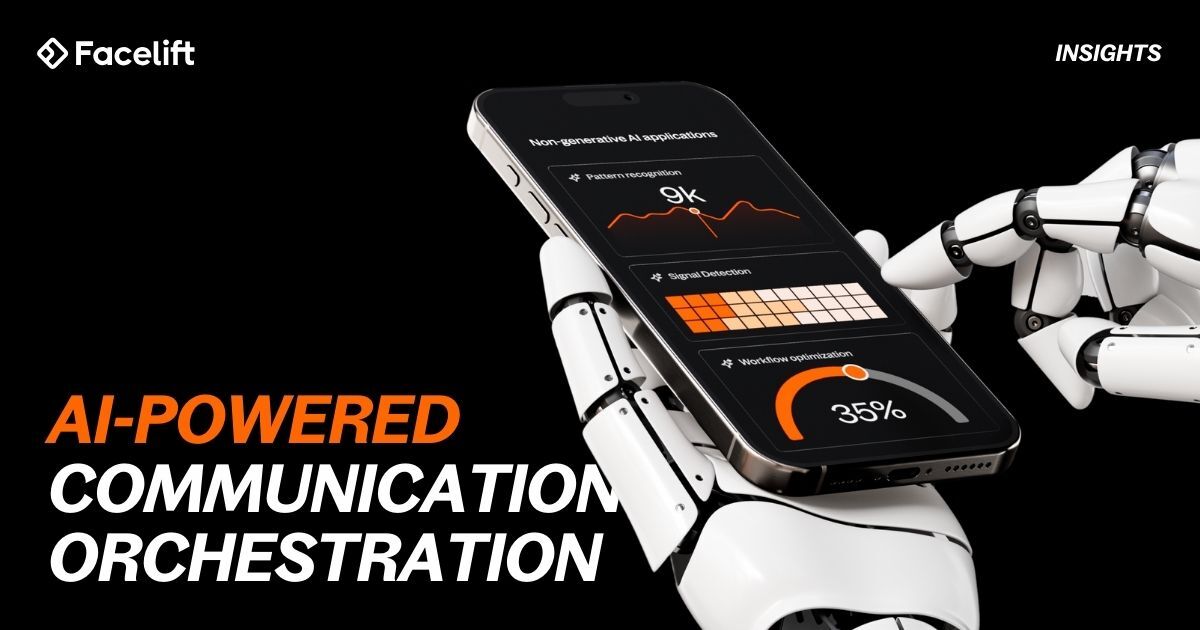1. Pattern Recognition Across Channels
Current state: Modern AI (especially natural language processors - NLPs) already helps brands maintain a consistent voice and spot deviations in tone or style across content channels. AI-driven platforms can automatically scan content against brand guidelines.
For example, they can flag off-brand language or inconsistent terminology before it goes live. These systems monitor communications in real time and can identify when the tone shifts away from the approved brand voice, prompting corrective suggestions to content creators. Such capabilities are available today in content quality tools and are sometimes underutilized beyond large enterprises.
Near-future: Over the next 1–2 years, expect broader adoption of multi-channel content auditing by AI. As organizations feed more style and strategy rules into AI models, the AI will become more adept at catching subtle inconsistencies or off-strategy messaging across social media, web, and internal communications. This means AI will move from just ensuring grammar/style to truly understanding strategy alignment. Thus, each piece of content, on any channel, will better adhere to the brand’s tone and strategic messaging guidelines.
2. Signal Detection and Anomaly Spotting
Current State: AI-driven analytics are increasingly used to detect anomalies in engagement and audience behavior data. Advanced social listening tools already combine sentiment analysis, trend detection, and anomaly alerts across platforms – for instance, sending an immediate alert if there’s a sudden change in engagement patterns or sentiment on social media.
In marketing analytics, anomaly detection algorithms continuously monitor performance metrics (clicks, traffic, conversions, etc.) and surface deviations that a human might miss. These systems highlight unusual drops or spikes, helping teams react quickly. For example, augmented analytics solutions can discover hidden issues in campaign data and surface critical insights in real time.
Google’s own AI in Analytics will flag unexpected traffic drops or conversion changes so businesses can respond before a small issue becomes a big problem. This capability exists now, though many organizations still rely on manual monitoring and thus underutilize the full potential of AI alerts.
Near-Future: In the coming 1–2 years, anomaly detection is expected to become even more proactive and integrated. AI tools will not only flag a drop in engagement or a surge in negative sentiment, but also automatically contextualize why it happened (e.g., identifying a particular content piece or external event that triggered the change). We’ll see more “early warning” systems in Communication Orchestration: AI will act as a sentinel, spotting brewing audience issues (from sudden unfollows to sentiment swings) and suggesting corrective actions immediately. This moves teams from reactive to proactive in managing engagement and audience sentiment.
3. Forecasting Bottlenecks in Workflows
Current state: AI-powered process mining is already helping to identify bottlenecks in content and communication workflows. By analyzing project logs and timelines, AI can highlight points where work stalls – for example, delays in an approval workflow or repetitive handoffs slowing the pipeline.
Current process mining tools (often used in operations and IT) have started to be applied to marketing/content processes, uncovering inefficiencies that manual tracking might miss. Some advanced systems use predictive analytics on historical project data to forecast where future delays are likely. In practice, this means AI can warn a team that, say, the content design stage might run late based on past patterns, or that a particular handoff between teams is a frequent friction point.
Indeed, AI-driven process mining solutions now offer predictive insights. They can foresee potential bottlenecks and prompt teams to take pre-emptive measures.
Near-future: In the next 1–2 years, these capabilities will become more commonplace in content operations. We can expect specialized workflow AI that continuously learns from how a communication team produces content (from brainstorming through publishing) and then predicts timeline risks.
Imagine an AI assistant that not only tracks task statuses but also says, “Given current progress and past projects, the Q3 campaign rollout is likely to be delayed at the review stage; here’s why and who is affected.”
Very cool.
Emerging AI tools could even automatically reroute tasks when a bottleneck is detected (for example, assigning content pieces to an available reviewer if one approver is overloaded). Such dynamic reallocation is on the horizon, aiming to keep content pipelines flowing smoothly by anticipating and resolving snags before they escalate.
4. Dynamic Prioritization of Content and Workflows
Current state: AI-based systems are beginning to dynamically re-prioritize content distribution and team tasks in response to real-time data. On the content side, marketers already leverage AI to catch emerging trends or changes in audience behavior and adjust on the fly.
For example, if an AI listening tool spots a new trending topic or a spike in interest from a certain demographic, it can suggest reallocating social media posts or ad spend to capitalize on that trend immediately. On the workflow side, advanced project management AI (sometimes in the form of multi-agent systems) can reorder task queues in real time.
A central AI “orchestrator” can monitor project data and team workloads, then dynamically assign or reprioritize tasks based on what will have the most impact or what risks becoming overdue. In practical terms, this means if certain campaign elements start underperforming, the AI might push “Plan B” content to the front of the publishing queue, or if one channel is suddenly driving high engagement, the AI raises its priority in the content calendar.
Near-future: We are on the cusp of truly adaptive campaign management. In the next couple of years, expect AI to be much more hands-on in day-to-day Communication Orchestration. AI copilots could continuously analyze content performance, audience responses, and even operational data (like team workload capacity), and then automatically re-balance priorities.
For example, an AI system might pause a less critical campaign when a new high-priority opportunity (or crisis!) emerges, reshuffling team focus in seconds. We’ll also see AI integrate external data – imagine reprioritizing content topics because an AI noticed a competitor’s big announcement or a sudden change in the news cycle. Essentially, orchestration will become more like a real-time strategy game, with AI as a tactical assistant ensuring resources (content, channels, and team effort) are always aligned with the latest conditions.
And that's how Communication Orchestration is supposed to work!
5. Proactive Misalignment Alerts
Current State: This capability – having AI flag campaigns or content that are out of step with business objectives – is just emerging. Currently, AI is mainly used to ensure consistency and analyze performance, but we are starting to see AI assist in strategy alignment too. For instance, some content strategy platforms can use AI to map each piece of content to the customer journey or conversion goal it’s meant to support.
Optimizely describes AI that can “map your content to specific conversion paths and identify strategic content gaps,” ensuring your content plan directly supports your business objectives. In practice, this could mean AI "noticing" if you’re publishing a bunch of content that doesn’t tie back to any key strategy pillar or objective, and then alerting you of this deficit.
At present, this kind of strategic alignment check is often manual (relying on marketers to cross-check content against strategy documents, which is fine, but not as efficient as it could be), but the building blocks are there: AI can understand content topics and can be fed business goal data.
Near-future: In the near term, expect AI to become a kind of strategy watchdog for communicators. Within 1–2 years, it’s realistic that your AI assistant will proactively warn, “This new campaign doesn’t appear to align with our Q1 objectives or messaging themes.” Future AI tools will likely ingest your company’s strategic priorities (product focuses, target segments, key messages) and constantly compare them against live campaigns.
If a piece of content or a social campaign is off-strategy – e.g., promoting a product line that isn’t a current priority or using messaging that doesn’t fit stated objectives – the AI will flag it immediately. This capability is emerging from the convergence of content intelligence and business analytics. As more marketing teams integrate their planning documents and KPI frameworks into AI systems, AI will track not just performance but also context.
Put simply, proactive misalignment alerts are on the horizon. They will help teams avoid wasted effort on off-strategy content and keep communication tightly aligned with business goals.
6. AI-Assisted Orchestration Retrospectives
Current State: AI is already enhancing campaign retrospectives by providing deeper analysis and narrative insights on what happened and why. Instead of a human pulling metrics and making a slide deck, AI-powered reporting tools can automatically generate summaries that go beyond raw numbers.
For example, agency analytics platforms now use AI to turn “data into clear, actionable insights in seconds,” highlighting key trends and successes in a campaign. These tools can analyze which messages resonated most, which channels underperformed, and even tie results to strategic goals (e.g., identifying which tactic drove the most high-value leads) without being explicitly asked.
In essence, AI can produce a first draft of a campaign post-mortem: not just what the performance metrics were, but why. Such capabilities are starting to be used by forward-looking teams now.
Near-Future: In the next couple of years, expect these AI retrospectives to become standard. As AI models get more specialized in marketing analytics, they’ll do more than chart performance, they will narrate the story of a campaign. We’ll see AI that can draft a written report saying, for example, “Campaign X increased web traffic 20%, but the AI notes this didn’t translate to sales, likely because it attracted a non-target audience segment. Meanwhile, the campaign heavily supported Objective A (brand awareness), but had a gap in supporting Objective B (product trial) compared to the plan.”
This kind of analysis moves beyond numbers to assess strategic contribution. Emerging AI will cross-reference campaign outcomes with the original campaign objectives and broader business outcomes, effectively grading how well the campaign furthered the strategy. Such retrospectives will save teams time and also surface insights humans might overlook, like subtle audience shifts or message-impact relationships.
Overall, AI-driven retrospectives will evolve from a novelty to a path of least resistance for extracting maximum learning from each campaign.
7. Dynamic Narrative Shaping in Real Time
Current state: AI can indeed help teams reshape messaging on the fly in response to external events or sentiment shifts, and this is a growing area of use. In PR and communications, professionals already use AI-powered social listening and media monitoring tools to get real-time alerts on spikes in coverage or changes in public sentiment.
These tools enable immediate adjustments to messaging. In practice, if stakeholder sentiment starts turning negative on a particular issue, AI alerts the team and may even suggest messaging tweaks or provide a draft response. Industry experts note that AI allows PR teams to “respond in real time to stakeholder sentiment,” rapidly drafting tailored messages to address evolving situations. We also see AI being used internally – for instance, some companies use AI to scan employee sentiment (through surveys or internal chat) and advise leaders on how to adjust internal comms tone instantly.
Near-future: Looking ahead 1-2 years, dynamic narrative shaping via AI will become even more sophisticated and proactive. We can expect AI systems that continuously ingest global news, social trends, and stakeholder feedback, and then automatically suggest narrative changes to content.
If a major external event (say a new regulation or a viral social media moment) occurs, the AI could alert your team and propose updated talking points or content adjustments to keep messaging relevant. Similarly, if an internal decision (like a sudden change in strategy or a crisis situation) needs to be communicated, AI language models could rapidly generate communication drafts tailored to different stakeholders (customers, employees, investors) to ensure consistency and alignment with the new direction.
Moreover, future AI might simulate how stakeholders are likely to react to a message (using sentiment and predictive analytics) and recommend tweaks before you even publish it. Essentially, AI will function as a real-time co-writer, helping communicators stay agile. Companies that embrace this will be able to “live-edit” their narratives: much like a GPS recalculating a route when conditions change, AI will recalibrate messaging in the moment to keep communications on strategy and well-received by their audiences.
Conclusion
It's quite common to see AI already being used to generate content all over social media and blog articles, but it's less common to see it acknowledged as a driver of business intelligence. This is partially because it's simply harder to see. On LinkedIn, my feed is little more than repetitive marketing gurus talking about how bright the future of simple content is, or cautious writers stating that they'll never be replaced.
But generative AI is really just scratching the surface. I think that the points above are arguably more important - and they're certainly more important to Communication Orchestration. Orchestration means building smarter content systems, building team alignment that keeps organizations branded across their entire company, and more.
In fact, it's not even dependent on tech. Communication Orchestration is intended to be tech-agnostic, and even though Facelift is the perfect solution to managing the needs of Communication Orchestration, it's a methodology that can be implemented with sticky notes.
We tried, and it works.
If you'd like to learn more about orchestration, specifically Social Media Orchestration, we've authored an in-depth white paper that outlines the past, present, and future of orchestration; where it came from, and where it's headed, and I highly recommend taking a look!




